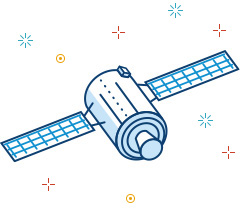
Satellite Communications Technology 101
Why is satellite an essential component of critical communication network planning?
Satellite communications (SATCOM) have been a trusted, reliable choice for public safety agencies’ mission-critical communication needs for nearly half a century. Unlike traditional wireline or cellular wireless systems, SATCOM uses satellites to “bounce” voice or data signals to or from a remote user through the sky and back to one or more geographically redundant downlink facilities (“earth stations”), which are connected to the global communications backbone networks. This enables communications virtually anywhere, as users have a “line-of-sight” path through the air to the satellite. Without satellite, any disaster response/COOP plan is at risk of falling apart when the traditional terrestrial and cellular networks sustain damage or get overloaded.
How Easy Is SATCOM To Use?
SATCOM services are as easy to use as a cellular phone. For example, anyone with experience making cellular phone calls can use today’s satellite phone. There are no special dialing prefixes or limitations on who can make or receive calls.
Inmarsat’s Broadband Global Area Network (BGAN) is available as laptop-size, portable antennas that anyone can set up in a few minutes with only minimal training. BGAN terminals are small enough to quickly pack, transport and set up literally in minutes, anywhere you go. BGAN can be mounted on platforms, including vehicles and boats with auto-tracking antennas that remain connected to the satellite as the user moves around with no manual intervention.


How Cost-effective is SATCOM?
SATCOM services offer a sound economical option to first responders, providing dependable and often the only communication capability that augments “terrestrial” (LTE cellular or wireline) communications for enhanced, robust connectivity.
FirstNet offers public safety customers Viasat Government Services’s readily available alternative delivered as a managed service capability that provides global, mobile connectivity the way first responders seek it: easily, affordably and operationally available, anywhere, anytime. With solid service level agreements and committed information rates, users get what they ask for and only use it when they need to, and the quality of the acquired service is assured.
Can Satellites Communicate Anywhere I Go?
Viasat Government Services offers ubiquitous satellite coverage no matter where. Without the need for land-based repeaters and radio links, users only need a standard subscription to set up their SATCOM terminals and have assured connectivity in minutes, regardless of location, even in remote and rural areas.
High-level coverage maps for the satellite services offered are shown below:
Iridium Satellite Phone Coverage
For detailed coverage maps in your area, please contact Viasat Government Services.


What Other Factors About SATCOM Are Important to Know?
- Because satellite signals are broadcast from orbital slots in geosynchronous orbit around the Earth vs a local cell or radio tower, additional latency is introduced into the connection. This results in up to a half second delay when making voice calls and may interfere with some highly latency-sensitive data applications.
- The SATCOM network is not directly integrated into the FirstNet LTE core.
- LTE specific features such as priority/preemption and the use of the Local Control Tool for prioritizing users are not available over satellite. SATCOM has its own security/encryption, traffic management and Quality of Service capabilities to help ensure high reliability and availability for public safety users.
